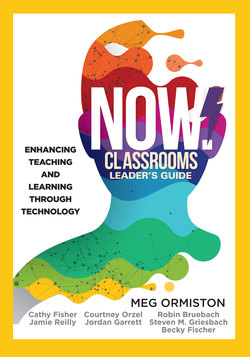Читать книгу NOW Classrooms Leader's Guide - Meg Ormiston - Страница 9
На сайте Литреса книга снята с продажи.
ОглавлениеPreface
This book is all about leading a change-focused school. Each member of this writing team is a practicing school or district administrator or education consultant, and although our journeys have been different, we all share a passion for thinking about how to launch students into the rapidly changing world outside of school, equipping them with the digital skills to be lifelong learners and change agents. We also share a passion for thinking about the best practices for you—a K–12 administrator who shares these goals—to help your team create the highly engaged and digitally enriched 21st century classrooms that will lead students to develop those skills. It’s with that passion that we wrote this guide for you.
We are in an age of acceleration, according to celebrated New York Times columnist and best-selling author Thomas L. Friedman. In his groundbreaking book Thank You for Being Late, Friedman (2016) writes, “There are vintage years in wine and vintage years in history, and 2007 was definitely one of the latter” (p. 20).
Why was the year 2007 so important? At the end of 2006, Facebook finally opened to anyone over thirteen with a valid email, and the social network scaled globally over the course of the following year. Apple released the first iPhone in 2007, combining the world’s best media player, a phone, and access to the Internet in one device. The microblogging company Twitter launched in 2007, and Amazon released the first Kindle ebook reader. Google bought YouTube in 2007. Airbnb was conceived that year. The list goes on and on.
Our students will graduate into this changing world of innovation and technology, and we need to do our very best to prepare them for this age of acceleration. As a school leader, you need to take charge of implementing that plan to bring innovation to your school—not just technological innovation, but an innovative approach to teaching and learning.
Eight Administrators Walk Into a Classroom …
Eight visiting administrators walk into a classroom. It sounds like the start of a joke, but in fact, it was the genesis of the NOW Classrooms series. Here is what we saw there.
It was a second-grade classroom, and groups of students were huddled around a device, actively engaged in creating a script for a video project on mammals and their habitats. Some group members were checking facts collected from various online and print resources, while others were sequencing the script or choosing digital images. Students worked in pairs, trios, and solo, but their interest and engagement in the project was obvious in every configuration. Not one student stopped learning to look at the eight visiting administrators, but when asked, each could explain the purpose of the project in his or her own words. The teacher monitored student progress, supported group problem solving, and reminded students that the project was to be published on the classroom web page in two days.
Across the hall, a third-grade class prepared for its Mystery Skype to start. Mystery Skype (https://education.microsoft.com/skype-in-the-classroom/mystery-skype) is a Microsoft Education initiative: a classroom sets up a Skype session with another classroom, and the students in each class must ask careful yes-or-no questions to determine where in the United States the other class is located. Sitting in teams, the third graders in our building took a few minutes to share strategies for locating the other class, making careful choices about what questions to ask and systematically planning the order in which to ask the questions. Each team’s table contained a printed map of the United States and a Chromebook showing Google Maps. Once the session started, the teams eliminated states from the map based on the other class’s answers, and they began to zero in on a location. The students were excited to see their questioning strategies in action and talked excitedly about how best to refine them.
In the building’s learning center, groups of first graders prepared to film their group book trailers. Every group was independently working on all different types of projects using a variety of tools: apps, laptops, an interactive whiteboard, large paper, digital cameras, books, and a green screen. Every student from each group could explain the learning goals of the activity, as well as the process his or her group had gone through in planning for their trailers.
We all wondered, “Is this kind of engagement normal?” The principal confirmed that it was; students learned like this every day in his school. It was common for him to walk into a classroom and see highly engaged students collaborating on challenging projects and lessons that were aligned to specific learner outcomes. Technology often supported this learning work, and teachers purposefully designed lessons to focus on communicating and critical thinking. The classrooms were rarely quiet.
The Series
Afterward, as we excitedly talked about our school visit, we tried to figure out how best to capture this magic and spread it to other classrooms. Our hope was to help leaders everywhere create schools where active, collaborative, and engaged learning happens for all students, all the time. As a result, we outlined this leadership book that afternoon, along with the four grade-band books of lessons in the NOW Classrooms series.
This is the first series we know of that details technology-driven teaching and learning from kindergarten through high school, as well as from the point of view of administrators and building leaders. We intended it to be a potential framework for any school district interested in bringing systemic change to classrooms at all grade levels. What an adventure it has been to write it, and we hope you find this book and the others in the NOW Classrooms series useful!
